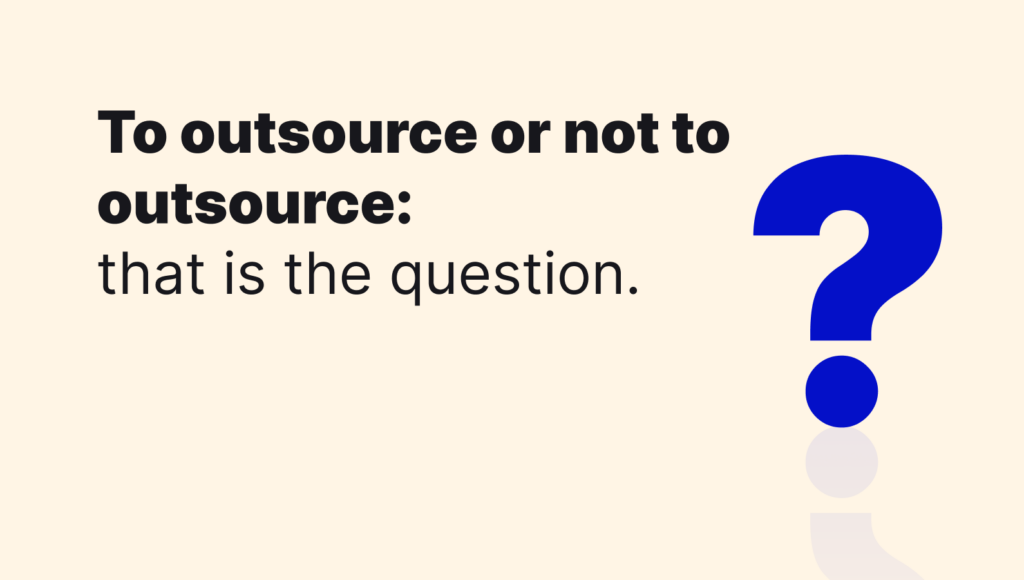Customer Support Training
CourseA free training program for training CS reps with the skills, tools, and knowledge to delight customers and resolve issues.
Learn how a strategic approach to outsourced teams can reduce costs, enhance performance, enrich company culture, and boost resilience.
The minute you change the lens and start to view outsourcing as part of a long-term strategic talent plan to build not only performance but dynamism and resilience into your operation, everything changes.
The moment you move from the short-term, last-minute scrabbling for outsourced talent to plug a gap, bridge a shortfall or tick a resource box, a myriad of benefits open up in front of you.
Though the gains from applying an integrated talent approach can be manifold, weve identified four measurable benefits that a strategic use of intelligently selected and properly integrated outsourced teams can bring:
Bottom line improvements and the cost-cutting that accompany them are a fact of operational life. When based on careful analysis, an intelligent and well-designed talent strategy that combines outsourced and in-house teams allows an organization to compete and serve while reducing costs over time, sometimes to a substantial degree. It minimizes financial risk by not only reducing operational, HR, and equipment costs but also by sharing that financial risk and cost with the talent service providers.
Fully integrated outsourced teams can have a substantial and measurable impact on improving efficiencies and productivity in your operation. When the deep organizational knowledge of your in-house teams is intimately coupled with the fresh expertise, technology, and resources that outsourced teams bring, you are better placed to manage systemic and operational bottlenecks, amplify existing competencies, and fast-track innovations and opportunities.
A Smarter Way to Build Your Global Team
When properly integrated, outsourced teams can help to positively impact the dynamism and productivity of an organizations in-house culture, bringing a fresh impetus, new ideas, and a diversity of skills and talents to the table that you would otherwise not have access to or could ill afford. It also alleviates pressure on the in-house teams, freeing people up to find more opportunities in what they do to be more and do more the fuel of a healthy culture.
In an increasingly volatile world, the ability to maintain the shape of your offering while flexing the material nature of your operation is critical to survival. Integrating outsourced teams with your in-house teams builds long-term resilience by giving you the agility required to ride turbulence and disruption. It allows you to flex talent when challenges and pressures on your operation arise, without overloading your bottom line. This approach can also build an innovation reflex into your operation, by enriching the perspectives of your in-house teams through exposure to a dynamic flow of diverse thinking and doing outside of their usual operational remit.

What leads people to outsource in the first place? The same thing that makes founders, directors, and managers of every size, shape, and kind of organization seek out incremental and radical improvements in every dimension of their operation at every opportunity.
Is it an exercise in overhead shrinking? To a point. Its all about the money and in the same breath, its nothing to do with the money. Its about survival.
Before you even get to finessing productivity and growing profits, you need to survive to stay in the game, operationally, and competitively.
The world is accelerating at speeds hitherto barely imaginable. With this comes an increasing degree of turbulence, with numerous sources of volatility affecting pretty much every business in every sector: from pricing, supply chain issues, and operational systems issues, to AI, innovation, and talent.
As a recent McKinsey report made very clear, everything is connected. Ready for Anything has to be the mantra
Repeatedly rebounding from disruption is tough, but some companies have a recipe for success: a systems mindset emphasizing agility, psychological safety, adaptable leadership, and cohesive culture.
McKinsey, Raising the resilience of your organization
Though there are increasing numbers of solutions for improving operational layers, hyper-accelerating the role of tech and systems, and sustaining an increasingly forensic focus on the management of overhead and the bottom line, ultimately people, and the quality and availability of them, is the make-or-break of any organization. Which is why talent strategies that reach beyond short-term survival mode and cost reduction are critical to both short- and long-term success.
But a lot of residual skepticism remains around the value of talent that is off-site and not directly stitched into the fabric of company culture, even when those employees are in-house and full-time. This is especially true in organisations where culture is central to their ethos as one CEO pointed out in a recent Telegraph article:
I know so many employees of so many companies other than LOral that have been working from home for months, that have absolutely no attachment, passion or creativity.
Nicolas Hieronimus, CEO of LOreal
A recent survey by Scalable Software revealed that 50% of the workers canvassed felt their employers had productivity paranoia. A recent Forbes piece and a survey by Microsoft echo the sentiment, stating that remote working can lead to work silos, damaging collaboration, stunting creativity, and thereby reducing innovation and productivity.
For some, this threat to the fabric of a companys culture only multiplies with the prospect of bringing in fully outsourced teams to work with an increasingly remote in-house workforce. For some, this presents a perfect talent storm that must be addressed before it irreversibly damages the fabric of their culture. In this LOreals head echoed the words of one of his predecessors
A company is neither walls nor buildings nor machines; the company is people.
Barbara Lavernos, Deputy CEO of LOreal

Ultimately, the responsibility for how an organization builds for a best-in-class talent strategy that combines external and in-house teams is dictated by the systems and practices put in place within the organization.
But building for a successfully integrated strategy, much like the Talent itself, starts from the outside in. It requires a more enlightened approach to, and selection of the right Talent partner searching, building, and managing the outsourced teams.
Inventory talent searches with little curation or expertise applied in the design and management of outsourced teams means that both the organization and the outsourced teams start at a disadvantage. When it comes to the inclusion of outsourced teams to best effect and greatest impact:
Employers have a duty to build sustaining processes that replicate proper workplace communications and the like.
Martin Tiplady, MD of Chameleon People Solutions
Many SBO platforms and providers offer robust, cost-saving solutions, but the degree to which the combination of an exceptional global talent pool, AI selection, and human curation is involved in the building of teams can often be hit and miss. When added to the cost premium most charge for taking over the task, that variability can become problematic. More importantly, it vests control from the organization leaving them hands off and flying blind on talent at the very time they need to be getting closer to it.
As several recent articles have suggested, if outsourced teams have been selected based solely upon very narrow task, role, and cost criteria, they will always exist outside the cultural walls.
Downsized companies stand to get their outsourcing wrong if they focus too much on KPIs (key performance indicators) and SLAs (service level agreements) as they fill their resource gaps. It is also crucial to have an alignment of company culture and values to work towards a shared vision that is built on trust.
MaryLou Costa, Raconteur
In a best-in-class integrated talent solution, using both in-house and outsourced teams, the outsourced kind need to be selected specifically to align on both values and culture as well as the standard narrow measures. In a recent Raconteur article, the importance of blending the teams is made all too clear.
A poor culture fit can lead to misunderstanding and conflict, which delay project delivery and have a negative impact on the quality of work. So its important that everyone is on the same page.
Richard Skellett, Founder of the Globalution Group
The need to keep outsourced teams looped into internal comms and social channels is paramount:
Outsourcing can only be effective with clear communications, operational oversight and a strong culture and values match for longer-term projects. This includes adding outsourced partners to team communication tools and setting expectations on areas such as how to give status updates, dealing with urgent requests and what response times should look like.
MaryLou Costa, Raconteur
The pressure on almost every company and organisation to guarantee the quality of delivery and to control the cost of that excellence and the premium they charge for it can create some innovative talent solutions. But these can, in turn, lead to a different set of issues and pressures that can negatively impact the organization or business. They are also custom-built for scale players who already have access to a vast pool of global talent.
Some organizations Unilever for example create internal talent markets that combine past and present Unilever colleagues, thus enabling the business to fill resource gaps with already-culturally-aligned people from a wider global pool. But, unlike Unilever, many organizations are not multinational leviathans with an extraordinary global talent reach and archive.
Also, central to the conversation is the issue of volatility of cost of services. With clients the world over increasingly pressuring companies to deliver more for less, the idea of a hybrid talent model as a robust way of shielding clients from inflationary talent costs is a good one - but as WPP found out, if the outsourced teams and individuals are not values & culture aligned, either with the internal teams or the clients they are serving, this can damage perceptions of the organization and the quality of its product.
Implementing a talent strategy that intelligently and sensitively combines outsourced teams with in-house teams is a smart thing to do.
It can measurably secure quality of delivery and drive productivity in the short term, and improve performance in the mid-term while increasing resilience in the long term. But it can only do this if those outsourced teams Feel, Think, and Do like in-house teams. This will only happen if the organization puts the right partners and processes in place to systemically build for the proper and sustained integration of the outsourced teams, not only operationally but both socially and culturally.
Work For Impact specializing in building outsourced teams that feel like in-house teams.
We deliver the best of both talent worlds with custom-built external teams designed to integrate with your operations, drive your performance, build your culture, and maximize your savings.
Work for Impact
Posted on
15/07/2024